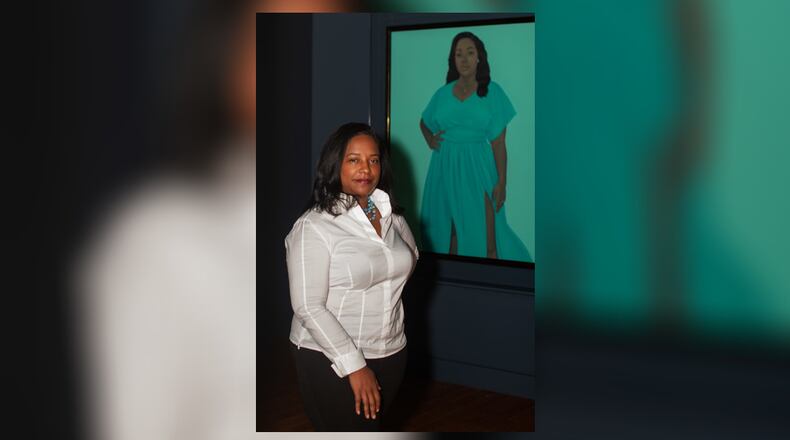Who better to chat with as we celebrate Black History month than a curator at the Smithsonian’s National Museum of African American History and Culture?
Lucky for us, the museum’s interim chief curator of visual arts has local connections. Tuliza Fleming is a 1990 graduate of Yellow Springs High School whose first full-time job was at the Dayton Art Institute as associate curator of American Art. At the DAI, she organized two of our museum’s popular exhibits: ”The Glass of Louis Comfort Tiffany” and “Monet and the Age of American Impressionism.”
Fleming has been in the news lately as the lead curator of the Washington museum’s exhibition, “Reckoning: Protest. Defiance. Resilience,” which opened in September. The exhibit, located in the newly designed Visual Art and the American Experience Gallery, documents the struggle Black Americans have faced in their pursuit to enjoy the fundamental rights and freedoms that are promised in the Constitution as citizens of the United States.
“I want visitors to this exhibit to learn about the variety of ways through which African-American artists have expressed their concerns regarding social justice in our nation,” Fleming says. “I also would like them to understand that Black artists are not just witnesses to these injustices but also activists in the struggle to improve the lives of all people in this country. Finally, I hope that visitors will see these issues through the lens of the artist and be called to action to make our society a better place.”
Credit: Smithsonian Institution, Nationa
Credit: Smithsonian Institution, Nationa
One of its most striking pieces of art is a portrait of Breonna Taylor, the black medical worker who was shot and killed in her apartment by Louisville police officers in 2020. The portrait, which pictures Taylor in a blue flowing gown, was painted by renowned artist Amy Sherald, who also painted the official portrait of First Lady Michelle Obama. You may have seen the portrait on the cover of “Vanity Fair ‘’ magazine. In this show it is surrounded by 27 newly exhibited images and artwork by Jean-Michel Basquiat, Sheila Pree Bright, Bisa Butler, Shaun Leonardo, David Hammons and others.
Fleming says she wants to make visitors aware of just how many years Black artists have been engaged in this type of endeavor. “It’s not just happening now,” she adds. “They’ve been doing this for 100 years!
“The exhibition seeks to forge connections between the Black Lives Matter protests, racial violence, grief and mourning, hope and change,” Fleming said, when first introducing the new exhibit to the public. “Additionally it reveals that many African-American artists feel they have more at stake beyond being included in the canon of American art.” The exhibit also talks about the role of women, the ways in which women have been active and have overcome social justice issues in this country.
If you’d like to visit the exhibit virtually, Fleming can give you a tour. You can access it at
A family business
If her last name rings a bell, it may be because Fleming is the daughter of Barbara and John Fleming of Yellow Springs. Her father is well known in the museum world. He’s a founding director of the National Afro-American Museum and Cultural Center in Wilberforce and served as the Underground Railroad Freedom Center’s director. He also served as Vice President of Museums at Cincinnati Museum Center at Union Terminal and directed the National Museum of African American Music in Nashville.
Born in Washington, Tuliza moved to Columbus with her family and later to Yellow Springs. “I loved to make art when I was a child and my parents always took me to museums and collected art by African Americans, " she says. “My parents would take me to the Columbus College of Art and Design for the weekend programs for children.”
Watching her father develop a museum gave her an appreciation and inside knowledge of a curator’s role as well as an appreciation of Black history and culture. ”In those days most museums weren’t collecting that kind of art,” she recalls. " Recently art museums have made concerted efforts to collect in that area. I wanted to make a difference and change the art world.”
Fleming, who obviously loves what she does, says the role of the curator is to oversee the permanent collection exhibitions, care for the collections and help acquire artwork. Her job also entails research, writing and public speaking. “It’s gratifying to be in a field where I love the work and have a strong appreciation for art and art history,” she says. “I think as a curator you’re always moving in new directions and learning about different artists. For me, it’s a wonderful career.”
She feels fortunate to work at the prestigious museum which opened in 2016 and has welcomed more than 7.5 million in-person visitors as well as millions through its digital presence. Since joining the staff Fleming has played a critical role in building the museum’s art collection which consisted of only two works of art when she was first hired in 2007. It was her suggestion to create an entire gallery in the museum focusing on artwork. She worked on the inaugural exhibition “Visual Art and the American Experience” and has also been published extensively.
The exciting news is that an online Searchable Museum has just been added to the National Museum of African American History and Culture which will eventually allow us to view all of the museum’s exhibits online. The first virtual exhibition, which includes first-person accounts and artifacts, is entitled " Slavery and Freedom.” It begins in the 14th century and concludes with the Civil War and Reconstruction.
“It’s really special,” says Fleming of the museum. “It gives viewers an opportunity to learn about the ways that historical moments, figures and other aspects of the African American experience are central and critical to the history and culture of our country. It’s information you wouldn’t otherwise be able to get in one day.”
Fleming advises parents of young children to read books about Black history and culture, visit museums, watch historically accurate films, and play trivia games that focus on African American history.
She says all Americans can honor Black History Month by learning about the history of African Americans in this country through avenues such as books and museums. “They can acknowledge the difficult issues that African Americans have encountered because of their race and make a commitment to improve these issues through personal action. They can also celebrate the important contributions that African Americans have made in the country and throughout the world.
SPECIAL COVERAGE: This is part of a series of Life & Arts stories celebrating Black History Month.
Jan. 30, 2022: ‘Black Life as Subject Matter II’ ranges from everyday life to protest
HOW TO GO:
Heading for DC? Admission to the Smithsonian’s National Museum of African American History and Culture is free, but free timed-entry passes are required for entry and a limited number are available. Visitors can reserve timed-entry passes online. An individual can reserve up to six timed-entry passes for their visit.
Meantime, you can check out the new Searchable Museum website which is free and does not require registration or sign-up to use. https://www.searchablemuseum.com/
Credit: Smithsonian Institution, Nationa
Credit: Smithsonian Institution, Nationa
About the Author








